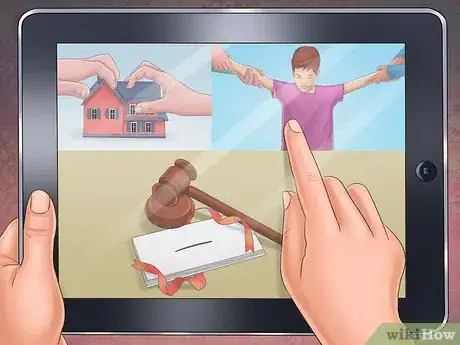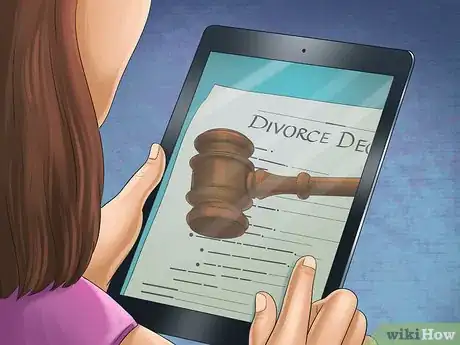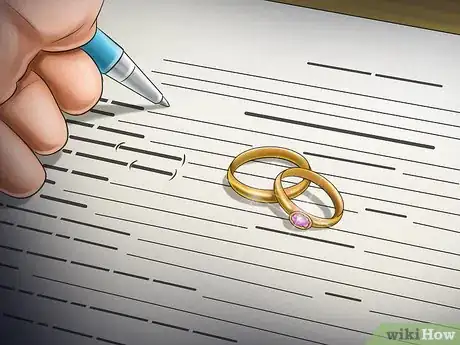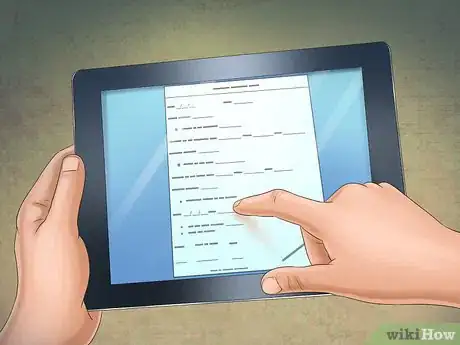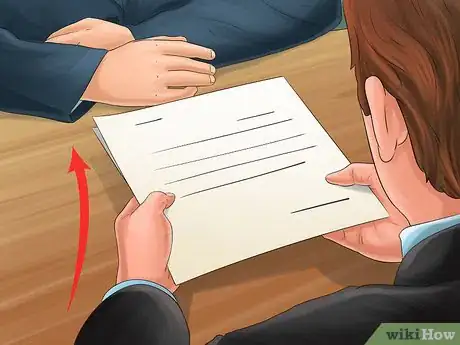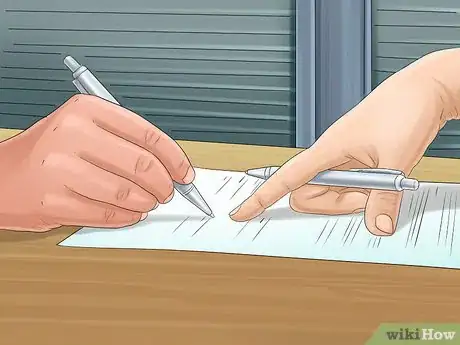This article was co-authored by Clinton M. Sandvick, JD, PhD. Clinton M. Sandvick worked as a civil litigator in California for over 7 years. He received his JD from the University of Wisconsin-Madison in 1998 and his PhD in American History from the University of Oregon in 2013.
There are 9 references cited in this article, which can be found at the bottom of the page.
This article has been viewed 152,194 times.
The way in which you begin a divorce will depend on your relationship with your spouse and the laws of the state in which you live. Some states allow for legal separation, while others view a marriage as legally valid until a court rules otherwise. In some cases, you may choose to petition the court for divorce without an attorney, while in others legal representation is important to a successful outcome. Spouses may also choose mediated divorce or collaborative divorce in order to minimize conflict and reduce attorney fees.
Steps
Selecting Best Method of Divorce
-
1Research legal separation. Legal separation, when a couple lives apart and formalizes their separation, is not a divorce. However, in some states, couples must be legally separated for a certain time period in order to file for a “no fault” divorce.[1] . A legal separation may be formalized in a written document or by court order.
- Determine your state’s laws about legal separation. State-specific laws regarding separation can be found here: http://www.hg.org/divorce-legal-separation.html.
- Consider the requirements of your state-specific law and negotiate with your spouse regarding the terms of your separation.
- Draft a separation agreement. Such agreement must comply with state law. A sample separation agreement can be found at: http://family.findlaw.com/divorce/sample-separation-agreement.html.
- If necessary under your state law, file your agreement with the designated state court.[2]
-
2Choose to represent yourself in the divorce. Many people negotiate their divorce without the assistance of an attorney. Instead, they rely on local court resources, self-help books or internet services about divorce. Choosing to represent yourself may be reasonable if:
- You are comfortable filing court documents and negotiating with your spouse.
- The parties are amicable, willing to work together, and mutually agree to pursue divorce.
- The assets to be divided do not include significant property.
- Your spouse is not hiring an attorney.
- You do not have any children.[3]
Advertisement -
3Agree to divorce mediation. You and your spouse may hire a neutral third-party, called a mediator, to help you negotiate the terms of your divorce. The goal of mediation is to create a legally binding “Judgment of Dissolution” laying out the parameters of your divorce. Mediators are focused on helping couples understand their options and propose solutions, but they do not give legal advice. A mediator may be a good choice if:
- Both parties share financial information freely and voluntarily.
- You and your spouse hope to maintain privacy regarding the terms of the divorce, rather than negotiating in court.
- You want help facilitating discussions about the plan for parenting and custody.
- You seek a lower-cost divorce.
- Even if you use a mediator to facilitate negotiations, you should consider hiring an attorney to review the settlement before it is finalized.[4]
-
4Pursue a collaborative divorce. With a collaborative divorce, both parties hire attorneys with the goal of negotiating an out-of-court settlement. Rather than represent individuals in court, collaborative attorneys facilitate the exchange of information and documents and ensure cooperative negotiating on issues of custody and property distribution.[5] A collaborative divorce may make sense for you if:
- The decision to divorce is mutual and the terms are not contentious.
- You and your spouse agree to a collaborative process.
- Both attorneys agree not to represent the parties in any divorce litigation.
- You and your spouse are willing to share all relevant documents and information.
- The parties agree to act in the best interest of their children, if any, and to avoid bargaining over the children as part of the divorce negotiations.[6]
-
5Hire an attorney. Sometimes it may be in your best interest to hire an attorney to handle your divorce. Attorneys who handle divorce are called family law attorneys and they understand the negotiation process, paperwork, and relevant court rules and proceedings. Hiring an attorney may be the right decision for you if:
- You suspect that your spouse is hiding assets or not disclosing accurate financial information.
- You anticipate that the divorce will be contentious.
- There is a dispute about who will get custody of your children.
- You are not comfortable completing and filing court documents.
- Your spouse has hired an attorney.[7]
-
6Find an experienced divorce attorney. You can locate attorneys in a variety of ways, such as:
- Referral from family or friends. Ask the person whether they would recommend the attorney that handled their divorce. Personal recommendations are a good way to identify high quality attorneys.
- Legal bar associations. Many local and state bar associations provide referral services to help you identify attorneys in your area. You can check, through state bar associations, whether any complaints have been filed against your prospective attorney. For a list of state-by-state resources to identify attorney referral sites (including state bar associations), visit the American Bar Association website at: http://apps.americanbar.org/legalservices/findlegalhelp/home.cfm
Preparing For Divorce
-
1Research the divorce laws in your state. Every state has its own laws regarding the dissolution of marriage. Once you have decided what method of divorce is best for your situation, you should educate yourself on the requirements for divorce in your state. You can locate state-specific divorce laws at: http://www.nolo.com/legal-encyclopedia/divorce-in-your-state-31013.html. Some questions that you should consider when preparing for divorce are:
- On what grounds can I file for divorce? Some states have “no fault” divorce, which means that you do not have to prove that either spouse did something wrong. Some spouses may seek a divorce based on fault, which can include cruelty, adultery, desertion or confinement to prison.[8]
- How will my property be divided? Depending on the state in which you live, your property may be divided as community property/separate property or through equitable division. In community property states, all property accumulated during the marriage is considered marital property and is divided evenly. If you owned property before the marriage that property is considered separate property and it is not subject to division. If you live in an equitable division state, a judge will try to decide what is fair and may not divide the property evenly.[9]
- How is child custody and child support handled. The guiding principle in all states regarding custody is a determination of what is in the best interest of the child. Most states have resources for parents to help them develop a custody agreement and parenting plan. Links to these resource can be found at: http://family.findlaw.com/child-custody/child-custody-and-visitation-information-by-state.html
-
2Gather financial documents. A large part of a divorce proceeding deals with the division or marital property. When preparing to file for divorce, you should gather the following financial documents:
- Federal and State income taxes for the previous five years.
- Paystubs and/or payroll statements.
- Documents concerning your retirement accounts, such as 401(k) plans, annuities, IRAs or other pension or retirement information.
- All insurance policies, including life, auto, health, and home.
- Deeds for property or contracts for leases.
- Any documents showing debt, including mortgage statements, student loan debt, loans, or credit card statements.
- Documents showing all bank accounts, including check books and bank statements.
- Documents showing household expenses, such as rent, utilities, food and clothing
- Household budget information.
- If you own a business, you should also gather all business documents detailing profit and loss.
-
3Locate divorce forms for your state. Most states have downloadable forms on their state court websites to simplify the divorce process. You can locate divorce forms for your state in the following ways:
- Conduct an internet search with the name of your state and “divorce forms.”
- Search state court websites for divorce forms. You can visit individual state-specific court websites by locating your state on the following website http://www.ncsc.org/Information-and-Resources/Browse-by-State/State-Court-Websites.aspx, and clicking on the link for your state. Once you are on the state website, use the search window to search for “divorce forms.”
- Call the court clerk. If you are unable to locate the forms online, contact the court clerk and ask them where you can find the specific forms. You can find the contact information for state-specific courts using the link above.
-
4Retain an attorney for specific tasks. Even if you choose to handle the majority of the divorce yourself, it is highly recommended that you at least hire an attorney to review any agreements pertaining to the divorce. As discussed above, you can locate an experienced family law attorney by a personal recommendation or by using state bar association’s attorney referral resources.
Filing for Divorce
-
1Determine where you can file for divorce. Most states and counties have residency requirements that establish where you can file for divorce. You must file for divorce in the appropriate county or your case may be dismissed. You can locate state-specific residency requirements here: http://family.findlaw.com/divorce/divorce-residency-faq-s.html.
-
2Fill out the appropriate legal document to commence divorce proceedings. States have different names for the document used to initiate divorce including: summons; petition for divorce; or complaint for divorce. This document should have been included in the divorce forms that you previously gathered. Generally, these documents will require the following information:
- Contact information for both spouses.
- Date and place of marriage.
- Information specifying residency and jurisdiction.
- Information regarding children, if any, including parentage, names, birth dates, and current custody arrangement.
- Information specifying assets and debt.
- Information specifying the grounds for divorce.[10]
-
3File the document with the appropriate state court. Typically, you will file your divorce petition in the county court where you reside so long as you meet the residency requirements discussed above. You should follow the rules for your specific court or contact the court clerk and ask what you need to do in order to properly file your divorce action. Generally courts require the following:
- Bring at least one original and two copies to the court clerk.
- Submit the documents to the court clerk for filing. The clerk will stamp all of the documents as filed, return the copies to you and keep the original.
- Pay a filing fee. Most courts will require that you pay a filing fee to commence an action. You should bring the fee in the appropriate form to the court at the time of filing. You may also be able to file for a waiver of the fee.[11]
-
4Serve the divorce petition on your spouse. After you file the divorce petition, you must legally provide a copy to your spouse in a manner set forth by state law. It is imperative that you properly serve your spouse or your divorce petition may be deemed invalid.[12] Generally, methods for service of process include:
- Personal service, which means that a person over the age of 18 personally hands the document to your spouse and fills out an affidavit describing the service. Depending on the state, process servers can include friends, family members, professional process servers, or law enforcement personnel.
- Service by mail. Many jurisdictions allow you to serve parties to a lawsuit or divorce by mail. Typically, you would send the document by U.S. mail, “return receipt requested,” so that you can demonstrate for the court that the document was delivered to the residence of your spouse.
- If you are unable to locate your spouse, some jurisdictions will allow you to serve by publication. This may mean that you are required to publish a notice in a newspaper where you believe your spouse resides. Most likely, you will be required to publish the notice over a course of weeks or months.[13]
-
5File proof of service. After serving the petition, most courts require that you file a document demonstrating proof that your spouse was properly served. It is very important that you submit this document because it is often used to start the time period for when your spouse has to file a response. Typically, you should be able to locate the proof of service form in the same location that you located the divorce forms.
References
- ↑ https://www.nj-divorces.com/how-to-begin-the-divorce-process/
- ↑ http://www.hg.org/divorce-legal-separation.html
- ↑ http://www.calbar.ca.gov/Public/Pamphlets/DivorceCustody.aspx#19; http://www.forbes.com/sites/jefflanders/2012/04/24/the-four-divorce-alternatives/
- ↑ http://www.calbar.ca.gov/Public/Pamphlets/DivorceCustody.aspx#19; http://www.forbes.com/sites/jefflanders/2012/04/24/the-four-divorce-alternatives/
- ↑ http://www.calbar.ca.gov/Public/Pamphlets/DivorceCustody.aspx#19; http://www.forbes.com/sites/jefflanders/2012/04/24/the-four-divorce-alternatives/
- ↑ http://www.cadivorce.com/california-divorce-guide/planning-for-a-california-divorce/collaborative-divorce/; http://www.forbes.com/sites/jefflanders/2012/04/24/the-four-divorce-alternatives/
- ↑ http://www.calbar.ca.gov/Public/Pamphlets/DivorceCustody.aspx#19
- ↑ http://www.nolo.com/legal-encyclopedia/no-fault-divorce-vs-fault-divorce-faq-29080-2.html
- ↑ http://family.findlaw.com/divorce/divorce-property-division-faq.html
- ↑ http://family.findlaw.com/divorce/filing-and-serving-the-divorce-dissolution-petition.html
- ↑ http://family.findlaw.com/divorce/filing-and-serving-the-divorce-dissolution-petition.html
- ↑ http://family.findlaw.com/divorce/filing-and-serving-the-divorce-dissolution-petition.html
- ↑ http://www.hg.org/article.asp?id=31553







